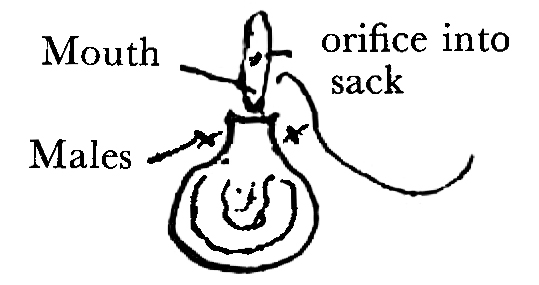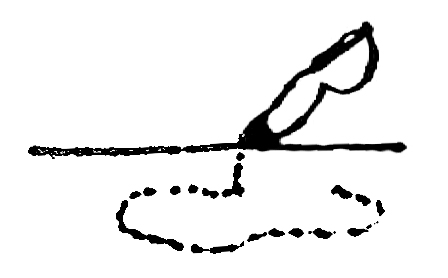To Albany Hancock 12 February [1853]
Down Farnborough Kent
(Feb. 12th.)
My dear Sir
I will begin a summary of what I have been able to make out on Alcippe,1 imagining you feel interest enough to read my scrawl: you must believe, that I express myself positively only for brevity sake.
Mouth: every part peculiar, but strictly on normal type of Lepadidæ: the rudimentary palpi, however, found only in Anelasma. I think your view on the row of hairs on Labrum being Branchial, must be given up; there are thinner but similar hairs on inner opposed tunic of sack, together serving as a fence to prevent anything crawling into sack by the sides of Labrum.
Cirri. The organ you have called palp. or first cirrus, certainly is the latter, & not much more modified than in Anelasma: the thoracic segment supporting this cirrus is confluent with mouth & forms the prosoma in normal manner. The second (N.B this is properly the 3d segment of archetype crustacean)2 thoracic segment is large & obscure; the 3d & 4th. very distinct. In one monstrous specimen, the 4th. segment bore an extra cirrus! showing that the segment is true. The 5th segment small, but quite distinct, & bears the pair of cirri nearest the mouth. The 6th. segment equally distinct bears the middle pair of cirri. The succeeding & outermost articulated organs are not cirri, but caudal appendages. The wonderful little cushion, is the inner ramus metamorphosed: the caudal appendages are never biramous & hence have not cushion. It deserves notice that Alepas cornuta has the inner rami of the 5th & 6th pair of cirri (& of no other rami) rudimentary, without muscles, & short. These 3 pair of organs in Alcippe are all in some respects in an embryonic condition.
Alimentary canal: œsophagus normal: biliary envelope thick & irregular as in Anelasma: rectum & anus none. I am positive of this latter fact, & it is the most curious point in the anatomy of the genus. Alcippe must always eject (as other cirripedes sometimes do) its excrement from mouth.
Acoustic & olfactory orifices as in Ibla: Eye not discovered. nervous system, hardly examined.
Female organs of generation, all quite normal, as described under the Lepadidæ. The ovigerous fræna are very large & are destitute (as in some species of Pollicipes) of glands: they probably serve as Branchiæ, as well as the universally admitted Branchiæ in sessile cirripedes, of which they are the homologues.
Male organs none, except a rudiment of penis in normal position between & on ventral side of 6th cirrus.3
I have forgotten to remark, that the external parts of animal, (capitulum & peduncle) do not essentially differ from same parts in Anelasma, though very peculiar.—
Metamorphoses: in 1st stage, I can add only the minute & lower antennæ. Most fortunately I detected some larvæ, just before their metamorphosis into Alcippe: they are peculiar in having their prehensile antennæ seated almost at very end of quasi-bivalve shell: the abdomen & caudal appendages are peculiar; but they have six pair of natatory thoracic legs & in all other respects resemble the pupæ of Lepadidæ.
Male Alcippe. Almost every female has from 1–3 or more males attached to her on both sides, externally, near the upper end of the horny shield or disc on the peduncle, in two little bags, where I have put a cross.
 The male is as transparent as glass; its lower end, (answering to the peduncle) is three lobed & caricatures the form of the same part in Alcippe; the other part (or capitulum), is flattened, much produced & of nearly same width througout, with small orifice at upper end. Total length 125th of an inch. In the lower part we have an eye, & great testis & vesicula seminalis: in the capitulum we have nothing but a tremendously long penis coiled up & which can be exserted. There is no mouth no stomach no cirri, no proper thorax! The whole animal is reduced to an envelope (homologically consisting of 3 first segments of head) containing the testes, vesicula, & penis. In male Ibla, we have hardly any cirri or thorax; in some male Scalpellums no mouth; here both negatives are united. I know it to be male of Alcippe from absolute identity of the pupæ of both sexes. & other reasons— I believe the males occur on every female: in one case I found 12 males & two pupæ on point of metamorphosis permanently attached by cement to one female!4
The male is as transparent as glass; its lower end, (answering to the peduncle) is three lobed & caricatures the form of the same part in Alcippe; the other part (or capitulum), is flattened, much produced & of nearly same width througout, with small orifice at upper end. Total length 125th of an inch. In the lower part we have an eye, & great testis & vesicula seminalis: in the capitulum we have nothing but a tremendously long penis coiled up & which can be exserted. There is no mouth no stomach no cirri, no proper thorax! The whole animal is reduced to an envelope (homologically consisting of 3 first segments of head) containing the testes, vesicula, & penis. In male Ibla, we have hardly any cirri or thorax; in some male Scalpellums no mouth; here both negatives are united. I know it to be male of Alcippe from absolute identity of the pupæ of both sexes. & other reasons— I believe the males occur on every female: in one case I found 12 males & two pupæ on point of metamorphosis permanently attached by cement to one female!4
Excavation of burrow. The outer skin or even the whole thickened edge of orifice into sack with its strong sharp spines is periodically & often moulted: there is great difference in the state of the star-headed spines on the new underlying, & the old worn spines on the old membrane: this being the case, & there being good motive power, in the long, & transverse & adductor muscles; I do not doubt the excavation is wholly mechanical.
 From the position of the larval antennæ, Alcippe after metamorphosis must occupy a position fully as much inclined or more inclined, than as drawn, & so would with only little change assume the position which it holds in the shell. Though I cannot demonstrate, I can show good reason to believe, that it moves its position, when first boring into the shell, just as Lithotrya does, a row of horny discs representing the calcareous overlapping discs in that genus. With respect to the edging or rim of shell, observed by you: it is quite inorganic, and has no more relation to Alcippe than the main part of the supporting coral-reef has to a coral: when dissolved in acid, it is found to contain all sorts of rubbish, even of foreign animals: it is a kind of natural mortar.— The rudely radiating dark lines & punctures in shell over peduncle of Alcippe are formed by a minute Annelid.—5
From the position of the larval antennæ, Alcippe after metamorphosis must occupy a position fully as much inclined or more inclined, than as drawn, & so would with only little change assume the position which it holds in the shell. Though I cannot demonstrate, I can show good reason to believe, that it moves its position, when first boring into the shell, just as Lithotrya does, a row of horny discs representing the calcareous overlapping discs in that genus. With respect to the edging or rim of shell, observed by you: it is quite inorganic, and has no more relation to Alcippe than the main part of the supporting coral-reef has to a coral: when dissolved in acid, it is found to contain all sorts of rubbish, even of foreign animals: it is a kind of natural mortar.— The rudely radiating dark lines & punctures in shell over peduncle of Alcippe are formed by a minute Annelid.—5
Affinities. I am dreadfully puzzled, & every day change whether to form a family for its reception, as in one point of view it most amply deserves., or to be guided by its varied close affinities to several genera amongst the Lepadidæ & place it in that family. I have never repented in placing Anelasma there;6 but what to do in this far more puzzling case I cannot yet tell.7
I fear my long rambling letter will puzzle & weary you. Accept my very sincere thanks for allowing me to examine this most curious cirripede, & believe me, my dear Sir | Your’s very truly | Charles Darwin
Footnotes
Bibliography
Living Cirripedia (1851): A monograph of the sub-class Cirripedia, with figures of all the species. The Lepadidæ; or, pedunculated cirripedes. By Charles Darwin. London: Ray Society. 1851.
Living Cirripedia (1854): A monograph of the sub-class Cirripedia, with figures of all the species. The Balanidæ (or sessile cirripedes); the Verrucidæ, etc. By Charles Darwin. London: Ray Society. 1854.
Summary
Describes anatomy and growth stages of Alcippe in close detail.
Letter details
- Letter no.
- DCP-LETT-1501
- From
- Charles Robert Darwin
- To
- Albany Hancock
- Sent from
- Down
- Source of text
- Archives of the New York Botanical Garden (Charles Finney Cox Collection)
- Physical description
- ALS 7pp
Please cite as
Darwin Correspondence Project, “Letter no. 1501,” accessed on 9 November 2024, https://www.darwinproject.ac.uk/letter/?docId=letters/DCP-LETT-1501.xml
Also published in The Correspondence of Charles Darwin, vol. 5


